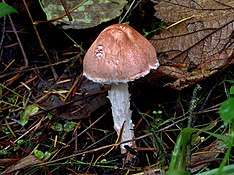Lepiota subincarnata
Lepiota subincarnata is a gilled mushroom of the genus Lepiota in the order Agaricales. It is known to contain amatoxins and consuming this fungus can be potentially lethal.[2] First described scientifically by the Danish mycologist Jakob Emanuel Lange in 1940,[3] the species is found in Asia, Europe, and North America.[4]
| Lepiota subincarnata | |
|---|---|
 | |
| Scientific classification | |
| Kingdom: | |
| Division: | |
| Class: | |
| Order: | |
| Family: | |
| Genus: | |
| Species: | L. subincarnata |
| Binomial name | |
| Lepiota subincarnata J.E.Lange (1940) | |
| Synonyms[1] | |
| |
| Lepiota subincarnata | |
|---|---|
float | |
| gills on hymenium | |
| cap is convex or flat | |
| hymenium is free | |
| stipe has a ring | |
| spore print is white | |
| ecology is mycorrhizal | |
| edibility: deadly | |
Bon and Boiffard described Lepiota josserandii in 1974, which turned out to be the same species.
See also
- List of deadly fungi
- List of Lepiota species
References
- "Lepiota subincarnata J.E. Lange 1940". MycoBank. International Mycological Association. Retrieved 2010-12-22.
- Hall IR. (2003). Edible and Poisonous Mushrooms of the World. Portland, Oregon: Timber Press. p. 107. ISBN 0-88192-586-1.
- Lange JE. (1940). Flora Agaricina Danica. 5.
- Razaq A, Vellinga EC, Ilyas S, Khalid AN (2013). "Lepiota brunneoincarnata and L. subincarnata: distribution and phylogeny". Mycotaxon. 126: 133–41. doi:10.5248/126.133.
This article is issued from Wikipedia. The text is licensed under Creative Commons - Attribution - Sharealike. Additional terms may apply for the media files.